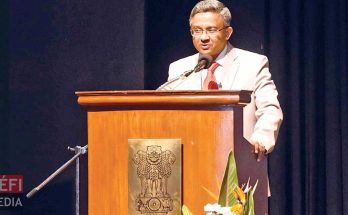 The first annual summit meeting between India’s Prime Minister Narendra Modi and Russian President Vladimir Putin has ended on a high note, with an all-encompassing vision statement that maps out the trajectory of this relationship over the next decade and signals a marked upswing in the economic relationship that seems ready to enter a higher trajectory after years of relative stagnation.
The first annual summit meeting between India’s Prime Minister Narendra Modi and Russian President Vladimir Putin has ended on a high note, with an all-encompassing vision statement that maps out the trajectory of this relationship over the next decade and signals a marked upswing in the economic relationship that seems ready to enter a higher trajectory after years of relative stagnation.
The summit meeting took place against the backdrop of the deepening chill between Russia and the West over the Ukraine crisis and the deals worth billions of dollars struck between India and Russia have predictably raised eyebrows. In essence, the Modi-Putin meeting underlined that India and Russia are ready to move beyond clichés of time-tested and special and privileged ties to provide more economic content and strategic heft to the relationship amid rapidly shifting geopolitical realities. While the remaking of the India-Russia relationship remains a work in progress and its success will depend on concrete follow-up actions on the 20 pacts signed between the two countries, here are five important takeaways from the first India-Russia summit held under the new dispensation in New Delhi:
Moscow will remain India’s key defence partner: Russia will remain India’s key defence partner despite New Delhi enhancing its military supplies from other powers, most importantly from Russia’s pet hate, the US. In a choreographed media statement after his wide-ranging talks with the Russian president, Mr Modi assured the latter that “even if India’s options have increased, Russia remains our most important defence partner,” and will remain so. Mr Modi’s assurance about Moscow’s pivotal place in India’s sourcing of cutting-edge weaponry should be music to the ears of the Russian leader, who is finding himself increasingly marginalised in the western world over his Ukraine policy. Moscow currently supplies over 60 per cent of New Delhi’s military imports.
The categorical assurance by New Delhi is significant as Mr Modi will host US President Barack Obama in a little over a month as the chief guest at the country’s Republic Day celebrations and one of the key outcomes during the visit is expected to be transformation of the India-US defence relationship across the spectrum. Much like Russia, the US is also playing with the same template of co-production and co-development of defence systems to enhance its share of India’s burgeoning military market, which has been liberalised by the Modi dispensation by hiking FDI in the defence sector to 49 per cent. By assuring Mr Putin that while India will do business with others, Russia will retain its pre-eminence, Mr Modi has sought to assuage those critics within Moscow’s diplomatic-strategic establishment who have tended to read too much into the burgeoning India-US relationship. Russia’s offer to manufacture light-utility helicopters in India, a landmark project when it comes to fruition, will not only aid Modi’s Make in India project but will also help Moscow consolidate its position in India’s military calculus.
Russia key partner in civil nuclear energy: Russia will also remain India’s preferred partner in the area of civil nuclear business. In this context, a separate vision statement on nuclear energy is specially significant as it spells out a roadmap for serial construction of Russian design nuclear reactors in India over the next decade. Besides the two reactors at Kudankulam in Tamil Nadu and four more planned at the same site, India has assured that it will be identifying a new site for another cluster of six atomic reactors, taking Russia-design reactors to 12 in the next decade. In the long term, it could entail Moscow building 20 nuclear reactors, giving it a prized position in India’s nuclear energy market, which under Mr Modi’s watch is expected to grow exponentially. In real terms, it amounts to business worth at least $30-40 billion for Russia’s nuclear industry and its state monopoly Rosatom. Another important facet of the revised roadmap is that Russia will source some of reactors components from Indian companies.
The swiftness with which India and Russia plan to proceed with the nuclear roadmap will inevitably trigger anxiety in the American camp as the US, which played a stellar role in India’s global nuclear rapprochement, has yet to get its act together, largely on account of its festering apprehensions over India’s civil nuclear liability regime which continues to be seen as onerous and forbidding by top US nuclear companies. In this context, all eyes will be on the forthcoming Modi-Obama meeting in January 2015 which is expected to create a concrete doable roadmap for the US-India collaboration in the field of nuclear energy.
Energising relationship: There is going to be a new burst of energy in India-Russia ties. Literally speaking. If one reads the joint statement carefully, one is struck by the prime importance attached to hydrocarbon cooperation and Russia’s zeal in offering oil and gas fields to Indian companies. India signalled its thrust on energy cooperation by sending Petroleum Minister Dharmendra Pradhan to welcome President Putin at the airport. The two sides have signed an ambitious programme of cooperation under Framework of Inter-governmental Agreement for Enhancement of Cooperation in Oil & Gas in 2015-16, which entails a wide array of projects including joint exploration and production of hydrocarbons, long term LNG supplies and joint study of a hydrocarbon pipeline system connecting Russia with India. The pact between TATA Power and Russian Direct Investment Fund (RDIF), which entails exploring investment opportunities in the energy sector across Russia also points to an increased salience of energy in overall India-Russia cooperation.
Remaking economic ties: Economically, the India-Russia relations, which have remained dismally underleveraged, may finally take off if procedural hurdles are addressed proactively, and a clutch of deals signed during Putin’s visit are implemented promptly. The two sides have raised the bar and set a more ambitious bilateral trade target of $30 billion by 2025. A decade should be enough to not only achieve the target, but even surpass it. Comparatively speaking, $30 billion is a modest target. By 2025, India-China bilateral trade could be around $150-200 billion. The US has set a target of quadrupling bilateral trade with India to $500 billion. But such comparisons can be misleading given the current volume of the India-Russia bilateral trade, which stands at a meagre $10 billion. In this context, the setting up of specialised investment funds is a potential game-changer.
The setting up of $1 billion investment fund, with IDFC (Infrastructure Development Finance Corporation Ltd) and RDIF (Russian Direct Investment Fund) partnering in the joint venture and a direct investment fund of US$ 2 billion between Rosnano and Indian investment partners for high-tech projects shows that the two sides mean business. The prospects of direct diamond trading, the $1 billion deal between VTB (Vneshtorgbank) of Russia and ESSAR Group and the agreement between ACRON of Russia and NMDC of India (consortium leader) to acquire stake in a potash mine in Russia are among important steps that look set to galvanise economic ties. Promoting Russian investments in India in major infrastructure projects like DMIC, Smart Cities and Freight Corridors, as well as in broader sectors like telecom, power and roads, fit perfectly into Modi’s Make in India initiative. Russia, on its part, has agreed to encourage Indian participation in Industrial Parks and technology platforms in sectors like pharmaceuticals, fertilizers, coal and energy. Additionally, the launch of negotiations between India and the Eurasian Economic Commission for a comprehensive economic cooperation agreement could have a force-multiplier effect on economic relations.
Global strategic partnership: One of the important, but less-publicised outcomes, of the latest India-Russia summit was a reaffirmation of their joint intent to “work together to promote a polycentric and democratic world order based on shared interests of all countries.” This may sound like a cliché, but if one unscrambles it, it means that for all the talk of India drifting into the American camp, India will retain its strategic autonomy and will cooperate closely with Moscow on a range of regional and global issues, including global terrorism, Afghanistan and nuclear proliferation. Significantly, President Putin has forcefully reiterated Russia’s support for India’s candidature for a permanent seat in the UN Security Council and the induction of India in top multilateral nuclear export regimes, including the NSG. Moscow will, therefore, remain pivotal to many of India’s cherished strategic global goals.
The Road Ahead
Taking a long-range view, the December 11 Modi-Putin summit has chalked out a detailed and creative template for transforming the India-Russia relationship that was drifting into stagnation and was getting entrapped in predictable diplomatic clichés. The 20 agreements signed during the summit, specially the economic and energy agreements, have huge transformative potential if they are brought to fruition within set deadlines. However, in the end the success of the remaking of the India-Russia relationship will depend on the continued centrality of strategic trust in the overall relationship.
Recent developments like Russia’s military pact with Pakistan and its increasing economic and military engagement with China have not played down well in India. And Russia’s diplomatic-strategic establishment is prone to see India as a US ally in the making. In diplomacy, perceptions matter, and trust is key to any privileged relationship. Having laid down an ambitious edifice and a renovated template of ‘Druzhba-Dosti,’ it’s critical to revitalise and nurture trust, which will be the enduring glue that will hold the new architecture together.
Author Profile

- Manish Chand is Founder-CEO and Editor-in-Chief of India Writes Network (www.indiawrites.org) and India and World, a pioneering magazine focused on international affairs. He is CEO/Director of TGII Media Private Limited, an India-based media, publishing, research and consultancy company.
Latest entries
 India and the WorldMarch 3, 2024India-Denmark Connect: Red carpet for Indians to Red Sea cooperation
India and the WorldMarch 3, 2024India-Denmark Connect: Red carpet for Indians to Red Sea cooperation India and the WorldFebruary 17, 2024Munich Security Conference: Jaishankar, Blinken focus on Red Sea, Middle East
India and the WorldFebruary 17, 2024Munich Security Conference: Jaishankar, Blinken focus on Red Sea, Middle East India and the WorldFebruary 14, 2024Munich Security Conference report: Migration, war top security threats
India and the WorldFebruary 14, 2024Munich Security Conference report: Migration, war top security threats India and the WorldJanuary 23, 2024With “Ram to Rashtra” mantra, Modi consecrates Ram temple for national renewal
India and the WorldJanuary 23, 2024With “Ram to Rashtra” mantra, Modi consecrates Ram temple for national renewal







